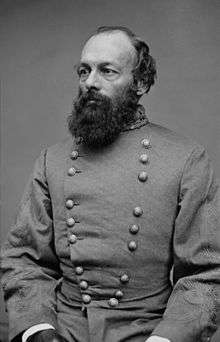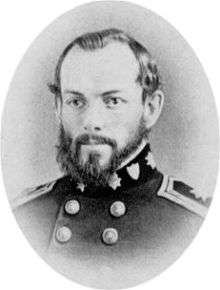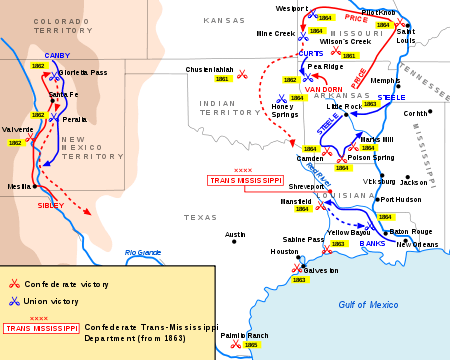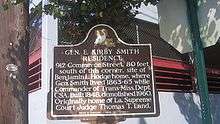Edmund Kirby Smith
| General Edmund Kirby Smith | |
|---|---|
 c. 1864 photograph | |
| Nickname(s) | "Ted", "Seminole" |
| Born |
May 16, 1824 St. Augustine, Florida |
| Died |
March 28, 1893 (aged 68) Sewanee, Tennessee |
| Place of burial |
University Cemetery, Sewanee, Tennessee |
| Allegiance |
|
| Service/ |
United States Army |
| Years of service |
1845–1861 (USA) 1861–1865 (CSA) |
| Rank |
|
| Commands held |
Third Corps, Army of Tennessee Trans-Mississippi Department |
| Battles/wars |
Mexican–American War American Civil War |
| Signature |
|
Edmund Kirby Smith (May 16, 1824 – March 28, 1893) was a career United States Army officer who fought in the Mexican–American War. He later joined the Confederate States Army in the Civil War, and was promoted to general in the first months of the war. He was notable for his command of the Trans-Mississippi Department after the fall of Vicksburg to the U.S.
Smith was wounded at First Bull Run and distinguished himself during the Heartland Offensive, the Confederacy's unsuccessful attempt to capture Kentucky in 1862. He was appointed as commander of the Trans-Mississippi Department in January 1863. The area included most actions east of the Rocky Mountains and west of the Mississippi River. In 1863, Smith dispatched troops in an unsuccessful attempt to relieve the Siege of Vicksburg. After Vicksburg was captured by the Union in July, the isolated Trans-Mississippi zone was cut off from the rest of the Confederacy, and became virtually an independent nation, nicknamed 'Kirby Smithdom'. In the Red River Campaign of Spring 1864, he commanded victorious Confederate troops under General Richard Taylor, who defeated a combined Union army/navy assault under Nathaniel P. Banks.
On June 2, 1865, Smith surrendered his army at Galveston, Texas, the last general with a major field force. He quickly escaped to Mexico and then to Cuba to avoid arrest for treason. His wife negotiated his return during the period when the federal government offered amnesty to those who would take an oath of loyalty. After the war, Smith worked in the telegraph and railway industries. He primarily served as a college professor of mathematics and botany at the University of the South in Tennessee. He is credited with the discovery of several species of plants in Tennessee and Florida.
Early life
Smith was born in 1824 in St. Augustine, Florida, as the youngest child of Joseph Lee Smith, an attorney, and Frances Kirby Smith. Both his parents were natives of Litchfield, Connecticut, where their older children were born. The family moved to Florida in 1821, as the senior Smith was appointed as a Superior Court judge in the new Florida Territory, acquired by the US from Spain.[1][2] Older siblings included Ephraim, born in 1807; and sisters Frances, born in 1809,[1] and Josephine, who died in 1835, likely of tuberculosis.[3][4] He was interested in botany and nature,[5] but in 1836, Smith's parents sent their second son to a military boarding school in Virginia,[6] and strongly encouraged a military career. He later enrolled in the United States Military Academy at West Point, New York.
In 1837, his sister Frances married Lucien Bonaparte Webster, a West Point graduate from Vermont and career Army artillery officer, whom she met when he was stationed at Fort Marion in St. Augustine. His commanding officer at the fort was the young Smiths' uncle. Webster later served in the Mexican–American War and died of yellow fever in 1853, when stationed on the Texas frontier at Fort Brown.[7]
Military education and career
On July 1, 1841, Kirby Smith entered West Point and graduated four years later in 1845, ranking 25th out of 41 cadets.[5] While there he was nicknamed "Seminole", after the Seminole people of Florida who had successfully resisted removal by the US. He was commissioned as a brevet second lieutenant in the 5th U.S. Infantry on July 1, 1845. Smith was promoted to second lieutenant on August 22, 1846, now serving in the 7th U.S. Infantry.[8]

In the Mexican–American War, Smith served under General Zachary Taylor at the Battle of Palo Alto and the Battle of Resaca de la Palma.[2] He served under General Winfield Scott later, and received brevet promotions to first lieutenant for Cerro Gordo and to captain for Contreras and Churubusco. His older brother, Ephraim Kirby Smith (1807–1847), who graduated from West Point in 1826 and was a captain in the regular army, served with him in the 5th U.S. Infantry in the campaigns with both Taylor and Scott. Ephraim died in 1847 from wounds suffered at the Battle of Molino del Rey.[6]
After that war, Kirby Smith served as a captain (from 1855) in the 2nd U.S. Cavalry, primarily in Texas. (From that year on through the war, Smith was accompanied by the youth Alexander Darnes, then 15, a mixed-race slave owned by his family, who served as his valet until emancipation.) (See photo of Darnes.)[9]
Kirby Smith also taught at West Point after the war. He collected and studied materials as a botanist; like many other military officers, he was also a scientist. He donated to the Smithsonian Institution some of his collection and reports from his time at West Point.[10] Smith continued his botanical studies as an avocation for the remainder of his life. He is credited with collecting and describing several species of plants native to Tennessee and Florida.[11]
Kirby Smith was assigned to teaching mathematics at West Point, from 1849 to 1852. According to his letters to his mother, he was happy with this environment.[12]
Assigned to active duty again, Smith served in the Southwest. On May 13, 1859, he was wounded in his thigh while fighting Comanche in the Nescutunga Valley of Texas.[2] When Texas seceded from the Union in 1861, Smith, now a major, refused to surrender his command at Camp Colorado in what is now Coleman, Texas, to the Texas State forces under Col. Benjamin McCulloch; he expressed his willingness to fight to hold it.[6] On January 31, 1861, Smith was promoted to major, but on April 6, he resigned his commission in the U.S. Army to join the Confederacy.[8]
Confederate Army and American Civil War
On March 16, 1861, Smith entered the Confederate forces as a major in the regular artillery; that day he was transferred to the regular cavalry with the rank of lieutenant colonel.[8] After serving briefly as Brig. Gen. Joseph E. Johnston's assistant adjutant general in the Shenandoah Valley,[13] Smith was promoted to brigadier general on June 17, 1861. He was given command of a brigade in the Army of the Shenandoah, which he led at the First Battle of Bull Run on July 21.[14] Wounded severely in the neck and shoulder, he recuperated while commanding the Department of Middle and East Florida. He returned to duty on October 11 as a major general and division commander in the Confederate Army of Northern Virginia.[15]
In February 1862, Smith was sent west to command the Army of East Tennessee. Cooperating with Gen. Braxton Bragg in the invasion of Kentucky, he scored a victory at the Battle of Richmond, Kentucky on August 30, 1862, but did not link up with Bragg's army until after the Battle of Perryville. On October 9, he was promoted to the newly created grade of lieutenant general, becoming a corps commander in Bragg's Army of Tennessee.[15] Smith received the Confederate "Thanks of Congress" on February 17, 1864, for his actions at Richmond.[lower-alpha 1]
Trans-Mississippi Department
On January 14, 1863, Smith was transferred to command the Trans-Mississippi Department (primarily Arkansas, Western Louisiana, and Texas) and he remained west of the Mississippi River for the balance of the war, based part of this time in Shreveport, Louisiana. As forces under Union Maj. Gen. Ulysses S. Grant tightened their grip on the river, Smith attempted to intervene. However, his department never had more than 30,000 men stationed over an immense area and he was not able to concentrate forces adequately to challenge Grant nor the Union Navy on the river.[15]

Following the Union capture of the remaining strongholds at Vicksburg and Port Hudson and their closing of the Mississippi to the enemy, Smith was virtually cut off from the Confederate capital at Richmond. He had to command a nearly independent area of the Confederacy, with all of the inherent administrative problems. The area became known in the Confederacy as "Kirby Smithdom".[16]

In the spring of 1864, Lt. Gen. Richard Taylor, directly under Smith's command, soundly defeated Maj. Gen. Nathaniel P. Banks at the Battle of Mansfield in the Red River Campaign on April 8, 1864.[17] After the Battle of Pleasant Hill on April 9, Smith joined Taylor and dispatched half of Taylor's army, Walker's Greyhounds, under the command of Maj. Gen. John George Walker, northward to defeat Union Maj. Gen. Frederick Steele's incursion into Arkansas. This decision, strongly opposed by Taylor, caused great enmity between the two men.[18]
With the pressure relieved to the north, Smith attempted to send reinforcements east of the Mississippi. But, as in the case of his earlier attempts to relieve Vicksburg, it proved impossible due to Union naval control of the river. Instead he dispatched Maj. Gen. Sterling Price, with all available cavalry, on an unsuccessful invasion of Missouri. Thereafter he conducted the war west of the river principally through small raids and guerrilla activity.[19]
By now a full general (as of February 19, 1864, one of seven generals in the Confederate Army),[15] Smith negotiated the surrender of his department on May 26, 1865. He was the last general to do so and signed the terms of surrender in Galveston, Texas, on June 2.[20] He immediately left the country for Mexico and then to Cuba, to escape potential prosecution for treason.[21] In August that year, General Beauregard's house near New Orleans was surrounded by Federal troops who suspected the general of harboring Smith. All the inhabitants were locked in a cotton press overnight. Beauregard complained to General Sheridan, who expressed his annoyance at the treatment of the high-ranking officer, his erstwhile enemy.[22] Smith returned to the United States later that year to take an oath of amnesty at Lynchburg, Virginia, on November 14, 1865.[8]
Marriage and family life
In August 1861, Kirby Smith met Cassie Selden (1836–1905), the daughter of Samuel S. Selden of Lynchburg. While recovering from being wounded at the First Battle of Manassas, he still found time for wooing. The couple married on September 24. Cassie wrote on October 10, 1862 from Lynchburg, asking what to name their first child. She suggested "something uncommon as I consider her an uncommon baby." The new baby was later named Caroline.[23]
The couple briefly reunited when Cassie followed her husband to Shreveport in February 1863. In the spring of 1864, she moved to Hempstead, Texas, where she remained for the duration of the war. After the war's end, Cassie traveled to Washington to negotiate for her husband's return to the United States.[24]
In 1875 Kirby Smith accepted an appointment as a professor at the University of the South in Sewanee, Tennessee. There the family lived happily until the end of his life. They had five sons and six daughters: Caroline (1862–1941), Frances (1864–1930), Edmund (1866–1938), Lydia (1868–1962), Nina (1870–1965), Elizabeth (1872–1937), Reynold (1874–1962), William (1876–1967), Josephine (1878–1961), Joseph Lee (1882–1939), and Ephraim (1884–1938).
Reynold, William, Joseph, and Ephraim all played for the Sewanee Tigers football team. Joseph and Ephraim both achieved All-Southern status in football. Joseph was a member of the famed 1899 "Iron Men" and Ephraim was selected for Sewanee's All-Time football team.
Postwar career
After the war, Kirby Smith was active in the telegraph business and in higher education. From 1866 to 1868, he was president of the Atlantic and Pacific Telegraph Company. When that effort ended in failure, he started a preparatory school in New Castle, Kentucky, which he directed until it burned in 1870.[6] In 1870, he combined efforts with former Confederate General Bushrod Johnson.[25] He served as the chancellor of the University of Nashville from 1870 to 1875.[26]
In 1875, Kirby Smith left that post to become professor of mathematics and botany at the University of the South at Sewanee, Tennessee.[5] Part of his collection from those years was donated to the universities of North Carolina and Harvard, and to the Smithsonian Institution. He kept up a correspondence with botanists at other institutions. He taught at the University of the South until 1893, when he died of pneumonia. At the time of his death in Sewanee, he was the last surviving man who had been a full general in the Civil War. He is buried in the University Cemetery at Sewanee.[6]
Legacy and honors
- His papers have been collected at the University of North Carolina, Chapel Hill, in Edmund Kirby-Smith Papers, 1776–1906 (bulk 1840–1866).[4]
- A dormitory building on the campus of LSU in Baton Rouge is named Edmund Kirby Smith Hall.
- A portrait of Edmund Kirby Smith by Cornelius Hankins hangs in the Wyatt Center at Vanderbilt University.[26]
- In 1922, the state of Florida erected a statue honoring General Smith in the National Statuary Hall Collection of the United States Capitol in Washington, D.C.[27][28] On March 19, 2018, Florida Governor Rick Scott signed legislation to replace the statue with one of African-American civil rights activist and educator Mary McLeod Bethune.[29] The statue was to be moved to the Lake County Historical Museum in Tavares, after residents of St. Augustine expressed no interest.[30] At a County Commission meeting on July 24, 2018, about 24 residents spoke against, and none in favor, of bringing the statue to Lake County. Chairman Sullivan assured the crowd that the commission would tell the Historical Museum "that there is no longer a want or desire to bring this statue to Lake County".[31]
- At the University of the South, he is commemorated by the Kirby-Smith Memorial on University Avenue, by Kirby-Smith Point on University Domain lands.
- The Kirby-Smith Chapter of the United Daughters of the Confederacy at Sewanee, and the Kirby-Smith Camp 1209, Sons of Confederate Veterans in Jacksonville, Florida, were named for him.
- Kirby Smith Middle School in Jacksonville was named for him.
- During World War II the 422-foot (129 m) liberty ship SS E. Kirby Smith was built in Panama City, Florida, in 1943 and named in his honor.[32]
- 2004, a life-sized statue of Kirby Smith and Alexander Darnes in an imagined meeting (see below) was made by Maria Kirby-Smith, a great-granddaughter of Smith.[5] It is installed in the courtyard of the Segui-Kirby Smith House, now owned by the St. Augustine Historical Society. This is the first public sculpture in the city to commemorate an African-American man.[9] Kirby-Smith said that she suspected Darnes was related to Smith as a half-brother or nephew, as her detailed work on the statues made her aware of the two men's close physical resemblance.[33]
Alexander Darnes
Alexander H. Darnes (1840 - February 11, 1894) was an African American born into slavery in the Joseph Lee Smith household in St. Augustine, Florida. He was the mixed-race son of Violet Pinkney, who served as a domestic servant in the household of Smith's parents, and an unnamed father. Maria Juliana Kirby-Smith, great-granddaughter of Smith and the sculptor who created a 2004 statue of the two men, said that she believes Darnes was related to Smith as a half-brother or nephew. Her study of their photos and detailed work on the statues made her aware of the two men's close physical resemblance.[33] Photos of the two men are held by the St. Augustine Historical Society; only one survives of Darnes.[9]
Darnes served as Smith's personal valet starting from 1855 and continuing throughout the Civil War. After emancipation and preparatory work, he gained an education with financial aid by Frances Smith Webster, sister of the general. Darnes graduated from Lincoln University and earned his medical degree at Howard University. He settled in Jacksonville, Florida as its first black physician and the second in the state, and had a successful career there.[9]
Though the statue is modern and was created to honor his memory, it along with other statues of Confederates have recently come under scrutiny because of the increased awareness of continuing racism and mistreatment of minority people.
See also
Notes
- ↑ "... for the signal victory achieved by him in the battle of Richmond, Kentucky, on the thirtieth of August, and to all officers and soldiers of his command engaged in that battle" (Eicher 2001, p. 494).
- 1 2 Webster & Webster 2000, p. .
- 1 2 3 Chisholm 1911, p. 260.
- ↑ Webster & Webster 2000, p. 14.
- 1 2 Edmund Kirby-Smith Papers, 1776–1906 (bulk 1840–1866), The Southern Historical Collection, University of North Carolina, accessed 25 November 2013
- 1 2 3 4 Matthew White, "Science, Race and Reunion: The Memorialization of Edmund Kirby Smith and His Slave Alexander Darnes", 2011 Phi Alpha Theta Biennial Conference, Orlando, Florida; Academia website
- 1 2 3 4 5 Nofi 1995, pp. 347–48.
- ↑ [Frances Marvin Smith Webster and Lucien Bonaparte Webster, The Websters: Letters of an American Army Family in Peace and War, 1836-1853], ed. by Van R. Baker, Kent State University, 2000
- 1 2 3 4 Eicher 2001, pp. 493–94.
- 1 2 3 4 "Alexander Darnes and Kirby Smith Share Rare History" Archived September 28, 2009, at the Wayback Machine., Jacksonville Historical Society
- ↑ Julie B. Maglio, "Sculpture of Confederate General to be removed from Statuary Hall in D.C.", Hernando Sun, 31 May 2016
- ↑ Small, John K. "Studies in the Botany of the Southeastern United States.-Ix. I. The Sessile-Flowered Trillia of the Southern States." Bulletin of the Torrey Botanical Club 24, no. 4 (1897): 169-178
- ↑ "Letter from Edmund K. Smith to Frances K. Smith, February 14, 1849", Edmund Kirby-Smith Papers, Record Group #404 Southern Historical Collection, The Wilson Library, University of North Carolina
- ↑ Lossing 1881, p. 1306.
- ↑ Wagner, Gallagher & Finkelman 2002, p. 422.
- 1 2 3 4 Cunningham 1992, p. 166.
- ↑ Davis 1999, p. 94.
- ↑ Maritime Activity Reports 1942, pp. 101–2.
- ↑ Sheehan-Dean 2007, pp. 145–47.
- ↑ Mechem & Malin 1964, p. 281.
- ↑ accessed 2 June 2011
- ↑ Townsend 2006, pp. 136–37.
- ↑ "AMERICA: ARRIVAL OF 'THE CUBA' ", The Manchester Guardian, 4 September 1865
- ↑ Jones 1955, pp. 177–79.
- ↑ "Mrs. Cassie Kirby-Smith". Confederate Veteran. 15: 563. 1907 – via archive.org.
- ↑ Morris, Roy Jr. (March 29, 2017). "Bushrod Johnson: Yankee Quaker, Confederate General". Warfare History Network. Retrieved November 17, 2017.
- 1 2 "Vanderbilt Collection - Peabody Campus - Wyatt Center: Edmund Kirby Smith". Tennessee Portrait Project. National Society of Colonial Dames of America in Tennessee. Retrieved May 3, 2018.
- ↑ "Edmund Kirby Smith". Retrieved September 17, 2018.
- ↑ "Florida House panel OKs bill to remove Confederate statue". Retrieved September 17, 2018.
- ↑ Sexton, Christine; Saunders, Jim (March 21, 2018). "Florida to replace Confederate statue at US Capitol with civil-rights leader". Palm Beach Post.
- ↑ Commentary: Statue of Confederate general is no 'piece of art,' has no place in Lake County museum Retrieved July 2, 2018
- ↑ McNiff, Tim (July 24, 2018). "Lake County Commission does about-face on confederate statue". Daily Commercial.
- ↑ Maritime Activity Reports 1942, p. 135.
- 1 2 James Call, "What if Gen. Kirby Smith’s statue was replaced by one of his former slave, Alex Darnes, M.D.?", Tallahassee Democrat, 05 June 2016
References

- Cunningham, Sumner A.; Sons of Confederate Veterans (Organization); Confederated Southern Memorial Association (U.S.); United Confederate Veterans; United Daughters of the Confederacy (1922), Confederate Veteran, S.A. Cunningham
- Davis, William C. (1999), The American Frontier: Pioneers, Settlers, & Cowboys, 1800-1899, Norman: University of Oklahoma Press, ISBN 978-0-8061-3129-0
- Eicher, John H.; Eicher, David J. (2001), Civil War High Commands, Stanford University Press, ISBN 978-0-8047-3641-1
- Jones, Katharine M. (1955), Heroines of Dixie, New York: Konecky & Konecky
- Lossing, Benson John (1881), Harpers' Popular Cyclopaedia of United States History from the Aboriginal Period to 1876, New York: Harper, OCLC 1446520
- Maritime Activity Reports (1942), Marine News, 29
- Mechem, Kirke; Malin, James Claude (1964), The Kansas Historical Quarterly, Kansas State Historical Society Missing or empty
|title=(help) - Nofi, Albert A. (1995), A Civil War Treasury: Being a Miscellany of Arms and Artillery, Facts and Figures, Legends and Lore, Muses and Minstrels, Personalities and People, New York: Da Capo Press, ISBN 978-0-306-80622-3 .
- Sheehan-Dean, Aaron (2007), Struggle for a Vast Future: The American Civil War, Oxford: Osprey Publishing, ISBN 978-1-84603-213-4
- Townsend, Stephen A. (2006), The Yankee Invasion of Texas, College Station: Texas A&M University Press, ISBN 978-1-58544-487-8
- Wagner, Margaret E.; Gallagher, Gary W.; Finkelman, Paul (2002), The Library of Congress Civil War Desk Reference, New York:: Simon & Schuster, ISBN 978-0-684-86350-4
- Webster, Frances Marvin Smith; Webster, Lucien Bonaparte (2000), Baker, Van R., ed., The Websters: Letters of an American Army Family in Peace and War, 1836-1853, Kent State University Press, ISBN 9780873386548
Further reading
- Forsyth, Michael J. (2003), The Camden Expedition of 1864 and the Opportunity Lost by the Confederacy to Change the Civil War. Jefferson, NC: McFarland & Co., ISBN 978-0-7864-1554-0.
- Parks, Joseph Howard (1954), General Edmund Kirby Smith, CSA. Baton Rouge: Louisiana State University Press, ISBN 978-0-8071-1800-9.
- Pollard, Edward Alfred (1867), Lee and His Lieutenants: Comprising the Early Life, Public Services, and Campaigns of General Robert E. Lee and His Companions in Arms, with a Record of Their Campaigns and Heroic Deeds. New York: E.B. Treat & Co, OCLC 1487259.
- Prushankin, Jeffery S. (2005), A Crisis in Confederate Command: Edmund Kirby Smith, Richard Taylor and the Army of the Trans-Mississippi. Baton Rouge: Louisiana State University Press, ISBN 978-0-8071-3088-9.
- Smith, Ephraim Kirby (2006), To Mexico with Scott: Letters of Captain E. Kirby Smith to His Wife, edited and with Introduction by R.M. Johnston, scanned and reissued.
- Sifakis, Stewart (1988), Who Was Who in the Civil War. New York: Facts on File, ISBN 978-0-8160-2202-1.
- Warner, Ezra J. Generals in Gray: Lives of the Confederate Commanders. Baton Rouge: Louisiana State University Press, 1959. ISBN 978-0-8071-0823-9.
External links
- Edmund Kirby Smith at Find a Grave
- Edmund Kirby-Smith Papers, Southern Historical Collection, Wilson Library, University of North Carolina at Chapel Hill
- Architect of the Capitol description and photo of Smith's statue
- Kirby-Smith Middle School website in Jacksonville, Florida
- Memorials at Sewanee
